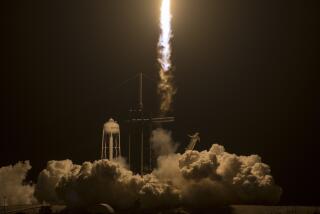Mir Space Station’s Scientific Usefulness in Doubt
- Share via
WASHINGTON — As the crew of the crippled Russian space station Mir worked to restore its power system and stabilize its orbit Thursday, U.S. officials said the scientific usefulness of the craft was badly compromised by the worst accident in the station’s troubled 11-year history Wednesday.
The bulk of American scientific work aboard Mir was being done in the Spektr laboratory module, which was hastily abandoned after being rammed and punctured by an unmanned supply craft.
Although experts said conditions on Mir are safe despite a 50% cut in the station’s electrical capacity that forced the crew to vastly reduce support systems, it is unclear how much of the ship’s research capability can be restored.
NASA officials are worried about the complexity of repairing the stricken outpost, which was launched in 1986 and is now well beyond its planned life expectancy.
“It is going to be a very difficult job,” said Frank Culbertson, NASA chief for the cooperative Mir missions. “It is going to be complicated for the crew. There is going to be hardware that will have to be built. You can’t take it lightly.”
The crew--American Michael Foale and Russians Vasily Tsibliyev and Alexander Lazutkin--has canceled all experiments and reduced TV transmissions for the time being. Even exercise--vital to fighting the debilitating effects of weightlessness--has been eliminated to avoid raising carbon dioxide levels.
The crew tried Thursday to realign the 140-ton Mir, which was knocked askew by the jolt of the collision, so the electricity-providing solar panels that are still functioning could catch as much sun as possible. But Russian Space Agency chief Yuri N. Koptev said lack of power prevented full alignment correction.
The exact cause of the accident remains unexplained. It occurred when the crew was practicing docking maneuvers with a Progress supply ship.
During tests of a new docking system, the supply ship went out of control and struck the Spektr module as well as a solar panel and a heat-exchange radiator, according to U.S. officials.
*
The crew heard air escaping into space and disconnected power supply lines inside Spektr, then used a wire cutter to sever data supply cables before slamming shut the hatch on the module, averting depressurization of the entire station, Culbertson said Thursday.
But the quick response also left Mir with only half of its normal electrical generating capacity, and its newest batteries were left behind in Spektr.
The astronauts spent much of Thursday reconfiguring the older batteries and attempting to recharge them with the remaining power supply. Once recharged, Mir should be able to restore normal lighting, ventilation and oxygen systems, according to Culbertson.
In addition to Spektr, Mir has four other modules to conduct a variety of astrophysics and biology experiments, but the modules all need more power to run those experiments than Mir can now supply.
Spektr, attached to Mir two years ago, had the most modern and efficient solar panels on the station and provided nearly half of Mir’s total electricity, said Sergei Gromov, spokesman for the Energiya rocket company that designed Mir.
Gromov said the crew is not short of supplies because Wednesday’s crash occurred during a rehearsal, and Progress vessels go to Mir about four times a year carrying fuel, food, scientific equipment and other items.
But when the crew sealed off Spektr, they left behind all the written records, computer disks and tapes containing data from American experiments, including extensive tests involving the effects of space on the human body.
*
Norman Thagard, a Florida State University professor who was formerly an astronaut aboard Mir, said the station can still host useful research without Spektr, though the loss of the module will hurt the U.S. program.
“It is an operational hit, but Mir is worth keeping without Spektr,” Thagard said.
Russian and American space officials describe conditions on Mir as safe, noting that temperature, humidity, oxygen and carbon dioxide are all at acceptable levels.
The crew feels “fine, although they went through a bit of stress” Wednesday, said Koptev, who added that the trio is in no danger.
Koptev said there is now no reason to evacuate the crew, which would have to leave only if air pressure fell to three-quarters of its usual level or below.
Still, Mir is little more than an orbiting station wagon--at least temporarily. Even at the best of times, Foale has said, working on the aging space station is like “a very dirty and grimy camping trip in an old car.”
Foale left his computer and other personal gear--even his toothbrush--inside Spektr.
To restore full power, the Russian space agency will have to find a way to route energy from the solar panels outside Spektr into the electrical grid serving the rest of Mir. The repair will require establishing new cables to run along the outside of Mir, or installing new cables inside Spektr and somehow passing them through Spektr’s air-tight hatch into the still-occupied sections of Mir.
The Russian space agency already has a plan to send specialized electrical cables on the next Progress supply ship, originally scheduled for launch today but now delayed for at least 10 days.
Although the repair job no doubt will be difficult, Russians have repeatedly “pulled rabbits out of their hats” to keep their spacecraft operating, said Marcia Smith, a U.S. space expert at the Congressional Research Service.
In the 1970s, Russians went on six space walks to fix a leaky valve by cutting a hole in the hull of the Salyut space station, Smith recalled.
Russian space officials conferred all day among themselves and with the astronauts by radio about how to repair the hole in Spektr’s side, which was seen on film shot by the crew to be smooth, round and several inches wide.
After a day of talks at the 72-strong committee of experts that included NASA representatives, Gromov remained unsure whether a space walk will be needed to undertake repairs or whether cosmonauts could do them from inside.
Smith, as well as other U.S. experts, said she doubts that a repair is likely any time soon.
John Pike, a space expert at the Federation of American Scientists, noted that the hatch in Spektr is so small--slightly more than two feet in diameter--that it may be impossible for an astronaut in a space suit to enter the module.
Culbertson also warned that the vacuum inside Spektr could have caused some equipment, such as batteries, to rupture and spew chemicals that may have contaminated the craft’s interior.
The accident now highlights the very risks that critics of a planned U.S.-headed international space station say have been underplayed: that a depressurization accident is a real possibility that could either jeopardize human life or cause losses worth tens of billions of dollars.
A NASA-appointed review panel, known as the Vest Commission, warned about fires and decompression incidents as risks for the planned space station; both have occurred on Mir this year.
Russian officials say they do not want to jettison Mir. They want it to go on working until 1999, after which it is scheduled to be replaced by the international station, Alpha.
Vartabedian reported from Washington, Bennett from Moscow.
More to Read
Sign up for Essential California
The most important California stories and recommendations in your inbox every morning.
You may occasionally receive promotional content from the Los Angeles Times.











